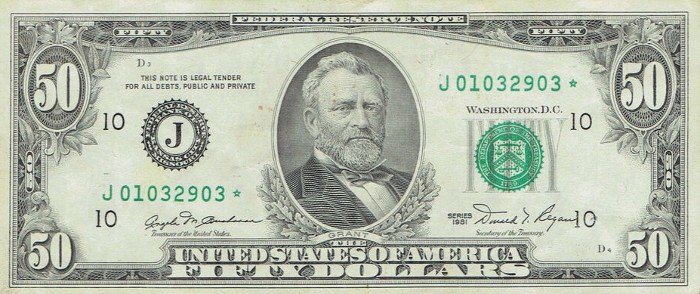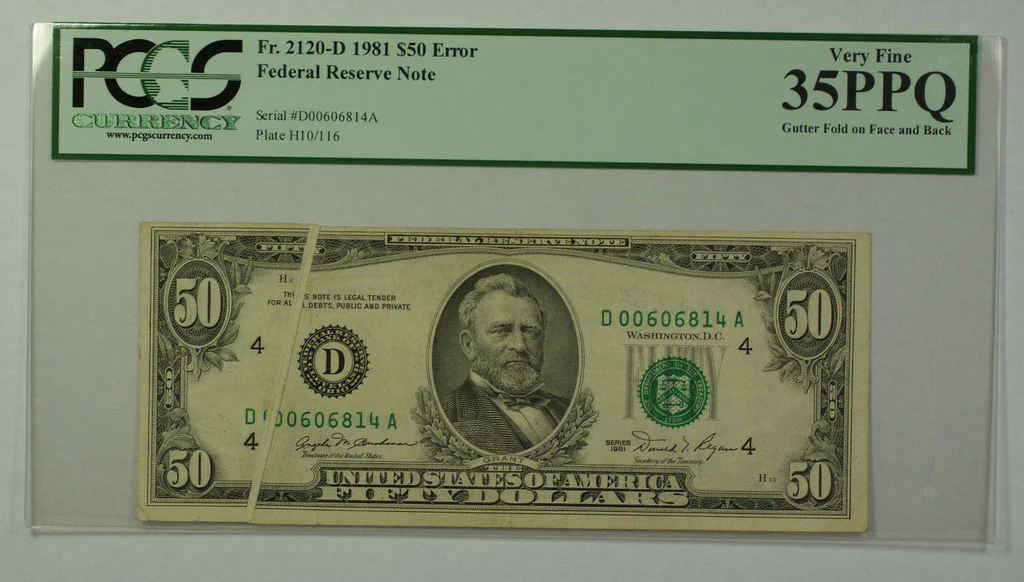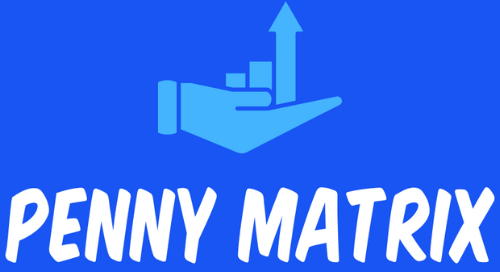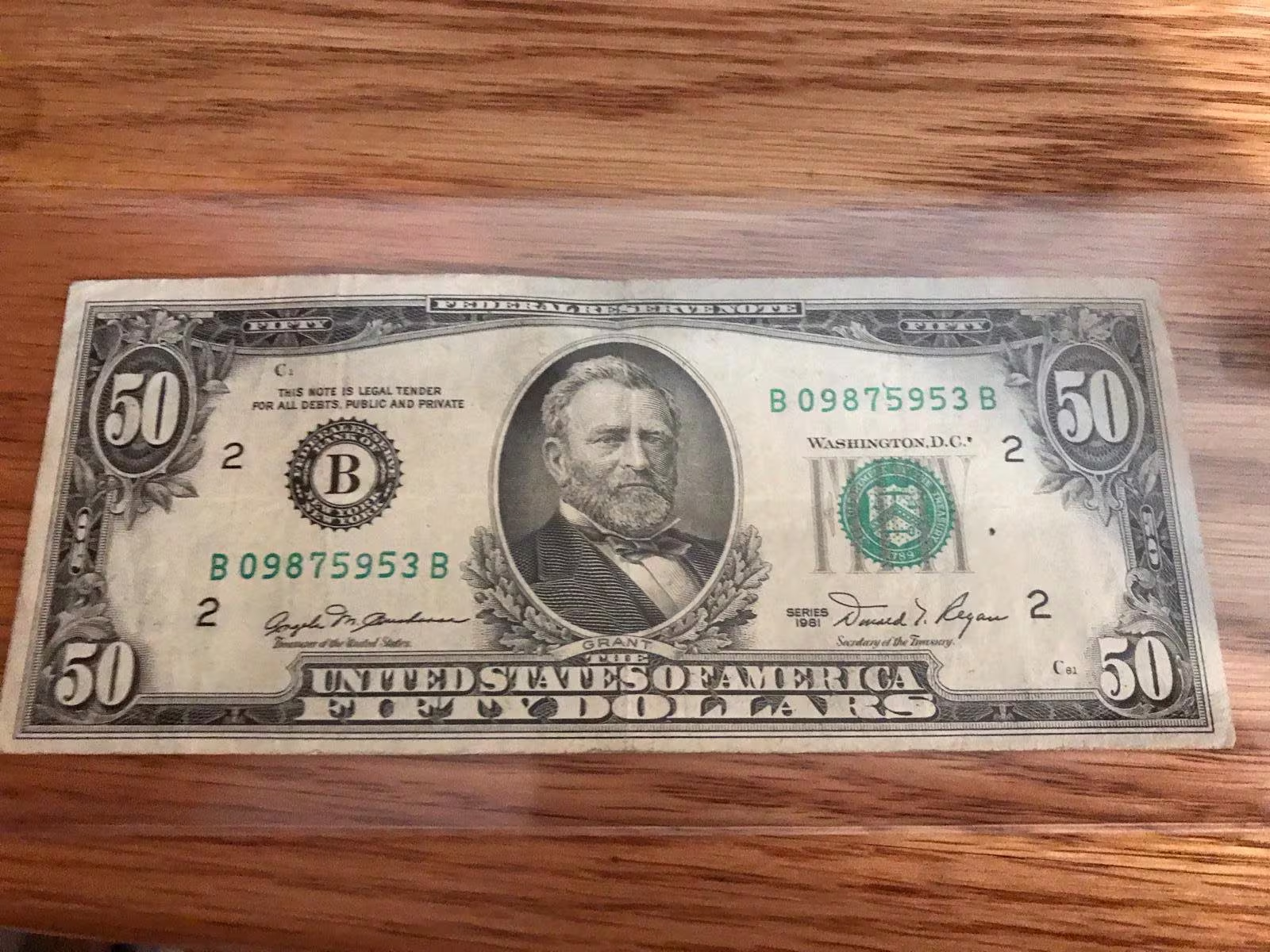When it comes to collecting paper money, the 1981 50 dollar bill is an interesting note for currency enthusiasts. Although most of these bills are not particularly rare or valuable in average condition, certain varieties of the 1981 series, such as star notes, can fetch much higher prices.
If you’re interested in the worth and unique features of the 1981 50 dollar bill, this article will provide a comprehensive guide, discussing its specifications, value, and factors that could influence its worth.
The 1981 50 Dollar Bill: Basic Specifications
The 1981 $50 bill, part of the Federal Reserve Note series, features a portrait of Ulysses S. Grant, the 18th president of the United States. As with other bills in the same denomination, the 1981 series was produced by the U.S. Treasury and is considered a standard issue of paper money.

The $50 bill is part of the larger 1981 series, which includes two sub-series: 1981 and 1981A.
Both sub-series are recognized for their distinct characteristics, but when it comes to the general design and appearance, there are few differences that would be noticeable to the casual observer.
Key Features of the 1981 $50 Bill
- Denomination: $50.00 USD
- Type: Federal Reserve Note
- Portrait: Ulysses S. Grant
- Series: 1981, 1981A
- Size: 6.14 inches by 2.61 inches
- Color: Predominantly green, with distinct elements of blue and black ink
For most collectors, these specifications are important when identifying genuine notes. However, the condition of the bill, along with specific details such as the presence of a star note or unique errors, will play a significant role in determining its market value.
How Much Is A 1981 50 Dollar Bill Worth?
The value of a 1981 50 dollar bill can vary based on several factors, including its condition and whether it’s part of a special set of notes. Most bills from the 1981 series are still circulating today and are commonly found in everyday transactions. When in average, circulated condition, they are worth exactly their face value of $50.
However, their worth can increase significantly in certain cases.
- Uncirculated Bills: A $50 bill from the 1981 series in uncirculated condition, rated with a grade of MS 63, typically ranges in value from $80 to $100. This value is higher than the bill’s face value due to its pristine condition and lack of any noticeable wear or folds.
- Federal Reserve Bank Notes: Certain 1981 series $50 bills, particularly those issued from specific Federal Reserve Banks, may carry a higher premium. For example, bills from the Minneapolis, Philadelphia, or St. Louis Federal Reserve Banks may sell for around $125 if in uncirculated condition with a grade of MS 63.
- 1981A Series: The 1981A series $50 bills generally have a slightly higher market value than the standard 1981 series bills. These are typically valued at around $100 in uncirculated condition with a grade of MS 63.
It is important to note that paper money prices can fluctuate based on demand, collector interest, and the overall rarity of the bill in question.
Star Notes and Their Significance
While most 1981 $50 bills are worth their face value or a small premium if they are uncirculated, star notes are a different story. Star notes are replacement bills printed by the Federal Reserve when an error is discovered in the printing process.
These replacement bills have a star symbol at the end of their serial numbers, signifying that they are part of the series issued to replace misprinted or damaged bills.

Star notes are more rare and thus tend to be more valuable than regular bills. For the 1981 series $50 bills, star notes can sell for a significant premium:
- 1981 Series Star Notes: A star note from the 1981 series in uncirculated condition with an MS 63 grade can be worth around $250. The rarity of these notes, combined with their unique status as replacements, contributes to their higher value in the currency market.
- 1981A Series Star Notes: Similarly, star notes from the 1981A series $50 bill can also be valued at approximately $250 in uncirculated condition. However, if the star note is from a more rare Federal Reserve Bank, such as Richmond, its value can rise significantly.
For instance, a star note from Richmond could be worth $475 or more.
Because of their rarity and higher demand among collectors, star notes are considered a sought-after feature for those collecting fifty dollar bill notes.
Factors Influencing The Value Of 1981 50 Dollar Bills
Aside from condition and whether the bill is a star note, several other factors can influence the value of a 1981 $50 bill:
- Serial Number: Some collectors may seek bills with unique or low serial numbers, such as those starting with several zeros. These bills may carry a premium depending on their desirability.
- Errors: Bills with printing errors or other defects may be considered valuable by certain collectors. Errors like misaligned printings, missing ink, or unusual serial number combinations can result in increased market interest and higher prices.
- Condition: The condition of the bill is perhaps the most critical factor in determining its worth. Bills that have been well-preserved without folds, stains, or creases are worth more than those that have visible signs of circulation. Uncirculated bills, especially those with a high grade (MS 63 or above), are typically valued more highly.
- Series and Sub-series: The specific year and sub-series (1981 vs. 1981A) can make a difference in price. Bills from certain years or sub-series may be rarer and thus attract higher collector interest.
Inflation and Historical Context Of The 1981 50 Dollar Bill
To put the value of the 1981 $50 bill into context, it’s essential to understand the effects of inflation. When the bill was first issued in 1981, $50 had a much greater purchasing power than it does today.
According to inflation data, $50 in 1981 is equivalent to approximately $173.60 in today’s money.
This means that the worth of $50 has decreased significantly over the past few decades due to inflation, which is a natural phenomenon affecting all currency over time.
This 50 dollar bill has thus seen its purchasing power diminish over the years, even as the physical value of the bill remains the same. While this isn’t necessarily a direct factor in the collector market, understanding the historical context of money helps underscore the significance of collecting older paper money.
How To Authenticate A 1981 50 Dollar Bill
For those interested in purchasing or selling a 1981 50 dollar bill, it’s crucial to be able to authenticate the bill properly to ensure its legitimacy.
There are a few key steps you can take to verify the authenticity of your bill:
- Watermark: Hold the bill up to the light and look for a watermark, typically a faint image of Ulysses S. Grant. Newer bills may have a face watermark, but older ones like the 1981 $50 bill may only show a faint spot.
- Security Features: Unlike bills from the 1990 series onward, the 1981 $50 bills do not have the plastic security strip that glows under UV light. If your bill does not feature this strip, it is not an error but a normal characteristic of older fifty dollar bill designs.
- Serial Numbers and Letter Series: Check the serial number to ensure it corresponds to the correct series and letter sequence. This is especially important when assessing the value of star notes or bills from specific Federal Reserve Banks.
Conclusion
The 1981 50 dollar bill offers a fascinating glimpse into the world of currency collecting. While most bills from this series aren’t particularly valuable, certain rare varieties, especially star notes, can fetch higher prices.
Uncirculated bills, errors, and notes from specific Federal Reserve Banks can also influence the worth of these paper notes.
If you happen to come across a 1981 $50 bill in your collection or through a transaction, remember to examine it closely for any distinguishing features, such as the presence of a star note or unique serial numbers.
By understanding the historical context, grading system, and factors that contribute to its value, you can make an informed decision about its market worth.
The 50 dollar bill from 1981 represents a piece of paper money with historical significance, and its market value may continue to grow as time goes on. Understanding the factors influencing the price of these notes is essential in navigating the world of currency collecting.

